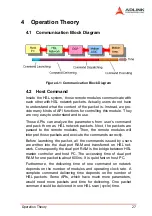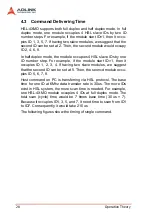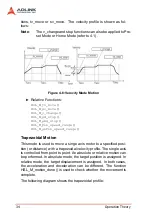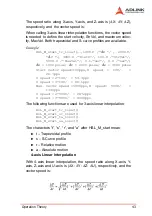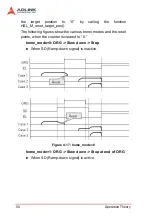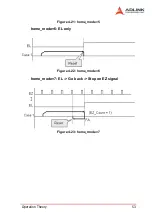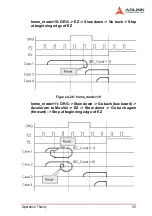
40
Operation Theory
The Following table shows the differences between all single axis
motion functions, including preset mode (both trapezoidal and S-
curve motion) and constant velocity mode.
Linear interpolation for 2-4 axes
In this mode, any 2 of the 4, 3 of the 4, or all 4 axes may be cho-
sen to perform linear interpolation. “Interpolation between multi-
axes” means these axes start simultaneously, and reach their end-
ing points at the same time. Linear means the ratio of speed of
every axis is a constant value.
Note that you cannot use 2 groups of 2 axes for linear interpolation
on a single card at the same time. You can however, use one 2-
axis linear and one 2-axis circular interpolation at the same time. If
you want to stop an interpolation group, the function
HSL_M_sd_stop() or HSL_M_emg_stop() can be used.
2 Axes Linear Interpolation
As in the diagram below, 2-axis linear interpolation means to move
the XY position (or any 2 of the 4 axis) from P0 to P1. The 2 axes
start and stop simultaneously, and the path is a straight line.
Velocity Profile
Trapezoidal S-Curve Relative Absolute
HSL_M_tv_move
Y
----------- -----------
HSL_M_sv_move
Y
----------- -----------
HSL_M_v_change
Y
Y
----------- -----------
HSL_M_sd_stop
Y
Y
----------- -----------
HSL_M_emg_stop()
-----------
------------ ----------- -----------
HSL_M_start_ta_move
Y
Y
HSL_M_start_sa_move
Y
Y
HSL_M_start_tr_move
Y
Y
HSL_M_start_sr_move
Y
Y
Table 4-3: Single Axis Motion Functions
Summary of Contents for HSL-4XMO
Page 4: ......
Page 16: ...6 Introduction ...
Page 36: ...26 Signal Connections ...
Page 67: ...Operation Theory 57 Home Search Example Home mode 1 Figure 4 29 Home Search Example ...
Page 108: ...98 Motion Creator in LinkMaster ...


